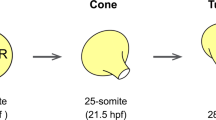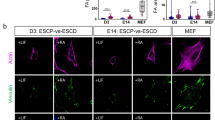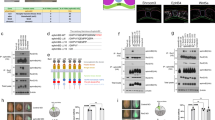Abstract
The migration of myocardial precursor cells towards the embryonic midline underlies the formation of the heart tube and is a key process of heart organogenesis. The zebrafish mutation miles-apart (mil), which affects the gene encoding a sphingosine-1-phosphate receptor, is characterized by defective migration of myocardial precursor cells and results in the formation of two laterally positioned hearts, a condition known as cardia bifida. The mechanism that disrupts myocardial migration in mil mutants remains largely unclear. To investigate how mil regulates this process, here we analyze the interactions between mil and other mediators of myocardial migration. We show that mil function is associated with the other known cardia bifida locus, natter/fibronectin (nat/fn), which encodes fibronectin, a major component of the extracellular matrix, in the control of myocardial migration. By using a primary culture system of embryonic zebrafish cells, we also show that signaling from the sphingosine-1-phosphate receptor regulates cell–fibronectin interactions in zebrafish. In addition, localized inhibition and activation of cell–fibronectin interactions during the stages of myocardial migration reveal that the temporal regulation of cell–fibronectin interaction by mil is required for proper myocardial migration. Our study reveals novel functional links between sphingosine-1-phosphate receptor signaling and cell–fibronectin interaction in the control of myocardial migration during zebrafish heart organogenesis.
Key Points
-
Myocardial migration is a key process of heart organogenesis
-
The mechanism underlying this process remains largely unknown
-
We analyzed this mechanism and found a positive interaction between miles apart and natter/fibronectin functions in the control of myocardial migration during zebrafish heart organogenesis
This is a preview of subscription content, access via your institution
Access options
Subscribe to this journal
Receive 12 print issues and online access
$209.00 per year
only $17.42 per issue
Buy this article
- Purchase on Springer Link
- Instant access to full article PDF
Prices may be subject to local taxes which are calculated during checkout



Similar content being viewed by others
References
Stainier DY (2001) Zebrafish genetics and vertebrate heart formation. Nat Rev Genet 2: 39–48
Yelon D et al. (2000) The bHLH transcription factor hand2 plays parallel roles in zebrafish heart and pectoral fin development. Development 127: 2573–2582
Reiter JF et al. (1999) Gata5 is required for the development of the heart and endoderm in zebrafish. Genes Dev 13: 2983–2995
Schier AF et al. (1997) The one-eyed pinhead gene functions in mesoderm and endoderm formation in zebrafish and interacts with no tail. Development 124: 327–342
Kikuchi Y et al. (2000) The zebrafish bonnie and clyde gene encodes a Mix family homeodomain protein that regulates the generation of endodermal precursors. Genes Dev 14: 1279–1289
Alexander J et al. (1999) casanova plays an early and essential role in endoderm formation in zebrafish. Dev Biol 215: 343–357
Komada M and Soriano P (1999) Hrs, a FYVE finger protein localized to early endosomes, is implicated in vesicular traffic and required for ventral folding morphogenesis. Genes Dev 13: 1475–1485
Li S et al. (2004) Advanced cardiac morphogenesis does not require heart tube fusion. Science 305: 1619–1622
Withington S et al. (2001) Foregut endoderm is required at head process stages for anteriormost neural patterning in chick. Development 128: 309–320
Matsui T et al. (2005) Noncanonical Wnt signaling regulates midline convergence of organ primordia during zebrafish development. Genes Dev 19: 164–175
Kupperman E et al. (2000) A sphingosine-1-phosphate receptor regulates cell migration during vertebrate heart development. Nature 406: 192–195
Trinh LA and Stainier DY (2004) Fibronectin regulates epithelial organization during myocardial migration in zebrafish. Dev Cell 6: 371–382
Ng JK et al. (2002) The limb identity gene Tbx5 promotes limb initiation by interacting with Wnt2b and Fgf10. Development 129: 5161–5170
George EL et al. (1993) Defects in mesoderm, neural tube and vascular development in mouse embryos lacking fibronectin. Development 119: 1079–1091
Linask KK and Lash JW (1988) A role for fibronectin in the migration of avian precardiac cells. I. Dose-dependent effects of fibronectin antibody. Dev Biol 129: 315–323
Zhang Q et al. (1999) Sphingosine 1-phosphate stimulates fibronectin matrix assembly through a Rho-dependent signal pathway. Blood 93: 2984–2990
Acknowledgements
We thank M Schwarz for help in preparing the manuscript. T Matsui is supported by a Japan Society for the Promotion of Science (JSPS) postdoctoral fellowship for Research Abroad. Á Raya was partially supported by a postdoctoral fellowship from Fundacion Inbiomed, Spain. C Callol-Massot and C Rodriguez-Esteban were partially supported by Biobide. I Oishi is supported by a postdoctoral fellowship from Centre de Medicina Regenerativa de Barcelona (CMRB), Spain. This work was supported by grants from the National Institutes of Health, Fundacion Cellex, and the G Harold and Leila Y Mathers Charitable Foundation to JC Izpisúa Belmonte.
Author information
Authors and Affiliations
Corresponding author
Ethics declarations
Competing interests
The authors declare no competing financial interests.
Rights and permissions
About this article
Cite this article
Matsui, T., Raya, Á., Callol-Massot, C. et al. miles-apart-Mediated regulation of cell–fibronectin interaction and myocardial migration in zebrafish. Nat Rev Cardiol 4 (Suppl 1), S77–S82 (2007). https://doi.org/10.1038/ncpcardio0764
Received:
Accepted:
Issue Date:
DOI: https://doi.org/10.1038/ncpcardio0764
This article is cited by
-
Laminin and Matrix metalloproteinase 11 regulate Fibronectin levels in the zebrafish myotendinous junction
Skeletal Muscle (2016)
-
Gene miles-apart is required for formation of otic vesicle and hair cells in zebrafish
Cell Death & Disease (2013)
-
Hsp27 is persistently expressed in zebrafish skeletal and cardiac muscle tissues but dispensable for their morphogenesis
Cell Stress and Chaperones (2009)



